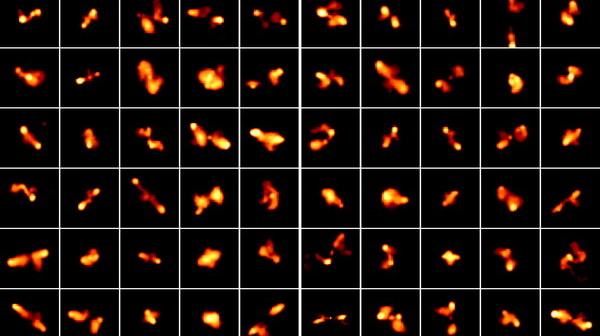X-shaped radio galaxies (XRGs) have been used as a measure of the frequency with which supermassive black holes (SMBHs) in the centers of galaxies coalesce after galaxy mergers. But a new study suggests that this approach may be over-predicting the merger rate — as well as the gravitational wave background resulting from it.
Flipping Axes
The dominant contributor to the gravitational wave background in low frequencies is thought to be the coalescence of two SMBHs during galaxy mergers. Predictions of the strength of the gravitational wave background — and, accordingly, our ability to detect it — require us to know how often such mergers occur.

A closer examination of three candidate XRGs. Top panel: J0702+5002, a possible case of backflow deflection. Middle panel: J0845+4031, a possible case of jet-axis precession. Bottom panel: J1043+3131, a possible case of a genuine jet-axis reorientation due to SMBHs coalescing. [Roberts et al. 2015]
But there’s a problem with using XRGs to estimate the merger frequencies, according to a new study led by David Roberts of Brandeis University: many of the sources identified might not be caused by mergers. Roberts and his coauthors set out to examine and characterize the extended structure of known XRGs to determine how many are actually signposts of SMBH coalescence.
Alternate Causes
The authors used archival data from the Very Large Array, which was available for 52 sources identified as candidate XRGs in the NRAO FIRST survey. By examining the high-resolution images of the archival data, the authors determined that in most of the sources, the X shape was probably not caused by the sudden flip of jet axes during SMBH coalescence. Instead, it was caused either by slow precession or drift of the axes, or by deflection of backflows from the jets as they impact the thermal halo of the host galaxy.
In the end, only 11 of the 52 sources examined were determined to be genuine cases of sudden axis reorientations. This means only 1.3% of extended radio sources appear to be indicators of a recent galaxy merger — significantly lower than the 7% abundance predicted by previous studies. The merger rate, rather than being the ~1 Gyr-1 galaxy-1 previously predicted, is therefore closer to 0.13 Gyr-1 galaxy-1.
What can we learn from this about gravitational waves? If it’s indeed the case that the number of galaxy mergers has been overestimated by studies using XRGs as signposts, then the associated gravitational wave background may be substantially smaller than these studies have predicted.
Citation
David H. Roberts et al 2015 ApJ 810 L6. doi:10.1088/2041-8205/810/1/L6

1 Comment
Pingback: SMBH merger rate revised down by factor of five.....